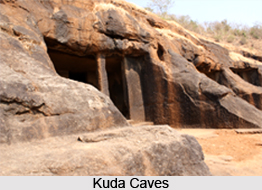 The Kuda Caves at Murud-Janjira creek, in central Maharashtra, are ancient rock-cut caves which contains paintings of Indian Buddhist art. There are 26 caves that were created around 1700 - 2100 years ago for the Buddhist monks of that time. The caves also include an assembly hallway, and there are numerous inscriptions of Buddhist religion. Sculptures are also present in the caves, but have originated later, approximately around the 5th-6th centuries. Few of the caves that are almost incomplete, contain the Dagoba, a sacred shrine. Other caves have balconies that include windows and doors on the back of the wall that leads to a chamber that contained rock cut benches, where the monks used to rest.
The Kuda Caves at Murud-Janjira creek, in central Maharashtra, are ancient rock-cut caves which contains paintings of Indian Buddhist art. There are 26 caves that were created around 1700 - 2100 years ago for the Buddhist monks of that time. The caves also include an assembly hallway, and there are numerous inscriptions of Buddhist religion. Sculptures are also present in the caves, but have originated later, approximately around the 5th-6th centuries. Few of the caves that are almost incomplete, contain the Dagoba, a sacred shrine. Other caves have balconies that include windows and doors on the back of the wall that leads to a chamber that contained rock cut benches, where the monks used to rest.
Most of the rock-cut caves of Buddhist origin were usually located near the trade routes or port based cities. The caves that were cut in the Hinayana custom are traced back between the 1st century BC - 3rd century AD. But later during the 6th - 7th century AD, more caves were created in the Mahayana custom, which involved various figures and statuettes of Lord Buddha.
In the Kuda Caves, there are 11 rock-cut reservoirs and around 26 rock-cut caves. Further more there are a few small chambers that also appear like more caves. Some caves are situated almost 45 - 60 m high above the sea level, which are chiseled on the sides of 75 m high cliffs. Most caves are compacted and in close locations; the external caves are within 200 m in range. The entrances are south-west facing which open to a stunning landscape view. According to the researchers, the caves are numbered between Cave I- XXVI.
Sculptures and Paintings in Kuda Caves
The statuettes, paintings and inscriptions on the fascia of the caves have been faded and eroded to great extent due natural forces. But the paintings and other artworks in the interior are better conserved. The inner portions of the Kuda caves are not much decorated and are mostly simple and basic. Cave VI has exotic and exquisite artworks and painting in the interior areas. The Walls of caves are plastered with mud and paddy husk and powdered rice. There are 6 inscriptions in Cave VI, among which, 5 inscriptions date back to the 5th - 6th Century AD. The inscriptions reveal the identities of contributors to the monastery.
Five of the caves are monasteries or Chaityas that contain the shrines, also known as dagobas, which are located inside. Few caves are also for lodging, known as Leni, which contains a balcony with windows and door on the back wall. Beyond the doors, existed various chamber containing cells for the monks to rest. Like most other rock-cut caves, the style of architecture, imitate replicate wooden style of architecture.
Description of Kuda Caves
Cave I contains a verandah, along with two pillars. Walls in hallway appear to have been plastered. Inscriptions above the door imply that Sivabhuti was amongst the benefactors. Cave II consists of a small courtyard and the Walls also appear to have been plastered. Cave III also mentions the name of the sponsor in the inscriptions. Cave IV consists of a front patio with benches and a verandah that has two pillars. Cave V has a cistern and also contains a verandah that one pillar. The inscriptions here portray a swastika and signify that Padumanika had donated the cave. Cave VI is a monastery or a chaitya and the most fascinating cave. A small statue of Buddha is located in the front area of the cave. The interior of the cave contains of various paintings in the walls, columns and ceiling. Cave VII has a Verandah with 2 pillars and the walls contain traces of plasters. The Verandah here states that Somadeva was a benefactor. Cave VIII is a quadrilateral chamber with area for monks to rest. Cave IX is a monastery or chaitya and has a shrine or dagoba. It also has verandah. The front area ahs been damaged in Cave X, and it boasts a small front yard. Cave XII is poorly damaged. There is an inscription which begins with a picture of lion. Cave XV is a monastery or chaitya and has a Verandah and a shrine. Cave XVI has 2 reservoirs. Cave XIX has simple courtyard, verandah and a chamber. Cave XXI is unfinished although it was planned and designed as chaitya. Cave XXII has a forecourt along with bench. There is a chamber inside the cave as well. The front portion of Cave XXV is damaged and Cave XXVI is linked with the previous cave by a wall which is partly damaged. There is a veranda in the cave and a chamber behind it.




